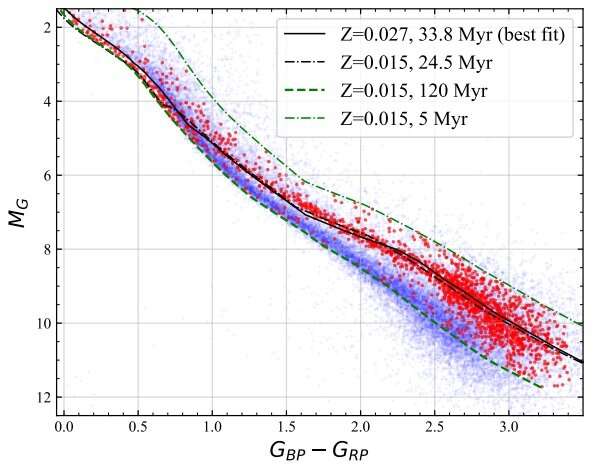June 3, 2020 report
Stellar 'snake' found in the cosmic neighborhood

Using data from various astronomical surveys, Chinese researchers have unveiled the presence of a quasi-tidal tail, dubbed stellar "snake" due to its morphology, in our cosmic neighborhood. The newly found structure could have implications for our understanding of formation and evolution of tidal tails. The finding is detailed in a paper published May 23 on arXiv.org.
In general, the so-called tidal tails are assumed to be the result of gravitational interactions between galaxies. For instance, when two galaxies orbit each other, tidal forces distort each galaxy, and these distorted regions are then ejected into intergalactic space, forming tidal tails.
Studying such features could be essential for improving our understanding about how galaxies interact with each other. Their observations have the potential to disclose important information on galactic collisions and mergers.
Now, a team of astronomers led by Hai-Jiun Tan of China Three Gorges University in Yichang, China, reports the detection of an interesting feature near the Orion Molecular Cloud Complex—one of the most active regions of nearby stellar formation. The finding was made by analyzing mainly astrometric and photometric data from ESA's Gaia satellite.
The newfound structure is referred to as quasi-tidal tail. This is due to the fact that its relatively young age does not allow astronomers to apply the classical theory of tidal tails.
According to the paper, the length and width of the stellar "snake" are over 750 light years, while its thickness is only about 260 light years. Almost 2,000 candidate members of this structure were identified, with an average distance of some 1,000 light years from the Earth.
The age of the feature's stellar population was estimated at between 30 and 40 million years. This means that the "snake" is much younger than any previously known tidal tails. The structure of the "snake" was also found to be atypical for tidal tails, as it has only one tail and includes two dissolving cores in its head.
"The two cores can be clearly distinguished in the 6-D phase space, [and] are probably broken from an open cluster with thousands of initial members in the same stellar population. The lost members are stretched into a long tail probably due to the disruption by the galactic tidal force," the astronomers wrote in the paper.
The researchers add that the shape of the "snake" suggest that its parent cluster has probably experienced one or several strong disruptions. However, the question about what mechanism stretched the parent cluster into a tail of size over 750 light years in such a relatively short time remains open.
In concluding remarks, the researchers say that their discovery of the stellar snake poses a challenge to the prevailing theory of formation and evolution of tidal tails.
"The current theory can well predict the tidal tails of the order of 100 million years old, such as the Hyades tidal tail, but it can not give a perfect explanation [for] this structure," the authors of the paper noted.
More information: Discovery of an ultra-young stellar "snake" with two dissolving cores in the solar neighborhood, arXiv:2005.12265 [astro-ph.GA] arxiv.org/abs/2005.12265
© 2020 Science X Network




















